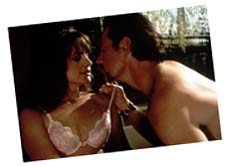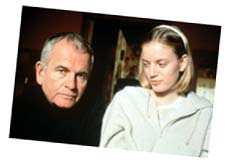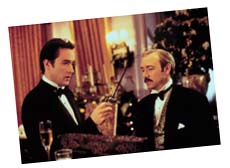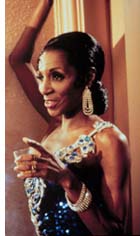Brain Teasers
Atom Egoyan and Clint Eastwood indulge a taste for ambiguity.
The Sweet Hereafter
Directed by Atom Egoyan
Fine Line Features
Midnight in the Garden of Good and Evil
Directed by Clint Eastwood
Warner Bros.

Atom Egoyan has an impressive body of work--at 37, he's made seven features--a recognizable style, and a signature personal obsession: the compulsive behavior that most movies either ignore or explain away with dumb clichés. His films are quirky, cerebral jigsaw puzzles. At first glance, his oddball Toronto characters (the voyeuristic laundress in Speaking Parts, the tax auditor in Exotica who pays a girl to baby-sit although he has no child) seem like isolated urban weirdos. But as their stories unfold in cryptic snippets, you see that their lives are interwoven with other people's, and you glimpse the damage that has made them so strange.

Teaming Egoyan with Russell Banks, the author of the novel The Sweet Hereafter, may sound like a mismatch--one is the bard of kinky Canadians, the other celebrates humdrum lives in rural America--but the book has a tragic heft that Egoyan's work has so far lacked. It follows events in a tiny hamlet in upstate New York after a school bus skids off an icy road, killing nearly every child in town. The story proceeds by way of monologues by four characters: Dolores Driscoll, the driver of the bus, who survives; Billy Ansell, a Vietnam vet who loses his twins; Mitchell Stephens, a city-slicker negligence lawyer who tries to convince the parents to sue the town; and Nicole Burnell, the only child to survive the accident, though she ends up in a wheelchair. Egoyan's version cleverly reworks these reminiscences into a dense thicket of flashbacks and flash-forwards, and moves the town to the awesome, edge-of-the-world wilderness of British Columbia. He also promotes the mysteriously angry character of the lawyer (Ian Holm) to the role of flawed hero.
Stephens seems to bring all the problems of modern life with him into the idyllic town. His daughter Zoe (Caerthan Banks, the novelist's daughter) is a junkie, and in the opening scene she calls his cell phone, wired and coyly manipulative, and hits him up for money. As a baby, we learn, Zoe was bitten by a black widow spider and her throat nearly closed up. Now it looks like Stephens has lost her for good. This theme of lost children runs rampant in Banks' original--he's a wonderful writer, but in a sentimental mood he could reel off a great tear-jerking speech for a politician promoting himself by crusading for the young. Children are surrounded by danger, even before the crash. Another child from the town disappears on a family vacation in Jamaica. Then there's the damage that dumbed-down, violent America has wrought: In his monologue in the novel, Stephens bitterly complains that we've lost our kids to street gangs and shopping malls and stupid TV.
Could be. And yet there's just a dollop of hysteria, of displaced baby-boomer self-pity, behind all this parental concern. Egoyan sees right through it. He preserves Stephens' tirade, but has Holm deliver it in a much more conflict-ridden, fake-sounding rant. In fact, Egoyan spends a good deal of energy knocking Banks' themes off kilter. He shot the film in anamorphic cinemascope, which takes us out of the characters' heads, heightening the blinding white of the snow on the mountains and summoning the expansiveness of myth. And he makes the characters less standard-issue all-American. In the novel, the teen-ager Nicole Burnell (Sarah Polley) was a cheerleader and the queen of the Harvest Ball, but Egoyan turns her into a pensive poetry reader who sings breathy soprano in an alternative rock band. In the novel, she angrily recalls being raped by her father, but in a flashback in the film we see the two of them surrounded by candles and preparing to kiss. It's a gentler, more disturbing picture of incest. The actor who plays the father, Tom McCamus, has long, lustrous, wavy black hair, which he cares for a little more lovingly than you'd like your dad to do. He looks like an aging teen idol.
This is Egoyan's method, to render his actors intriguingly alien. Too often, though, they wind up looking stilted. Holm pits decades of experience against Egoyan's Brechtian technique, with the result that he's a magnificent presence among wisps. Bruce Greenwood, who starred in Egoyan's Exotica, is competent but aggressively generic as the grieving vet Ansell (it's not for nothing that Canadians have cast Greenwood in their equivalent of the Kevin Bacon game). Even the actress who plays a motel owner having an affair with Ansell, Alberta Watson, who was so outrageous as the sicko incestuous mother in Spanking the Monkey, looks wan here. Toward the end of The Sweet Hereafter a turning point arrives, and the town is forced to let go of its hunt for blame. The moment ought to be cathartic, but it comes as no surprise. Throughout the film Egoyan's affectlessness has been whispering to us that life is a puzzle without a solution. The price for this lesson is that his characters seem like mere pieces in that puzzle.

T he beginning of the film version of John Berendt's nonfiction phenomenon, Midnight in the Garden of Good and Evil, is leisurely, with shots of a mossy Savannah, Ga., accompanied by a whistling wind. A reporter from New York, John Kelso (John Cusack, a fictionalized stand-in for Berendt), lands at the airport and drives into town, where he marvels at the beautiful, decrepit mansions. He sees a black man walking a leash with no dog attached to it, and later that night a garish, fat woman laughs and waves a loaded gun. You think that maybe the director, Clint Eastwood, has found a way to film that least filmable of genres, literary reportage, with its delight in crazy people and random sights. But after this great setup, Eastwood abandons the fun of Berendt's book--the digressions into Civil War history, the particularities of Savannahian speech--and tries to hook us with plot.
Kelso is in town to do a magazine piece about an annual party held by self-made socialite Jim Williams (a graying, mustachioed Kevin Spacey). At the party, Kelso witnesses a spat between Williams and a volatile young hunk (Jude Law). Later that night he finds out that Williams has shot and killed the hunk, who turns out to have been his lover, and that he's under arrest claiming self-defense. Kelso decides to stay in Savannah and write a book, trading his research to Williams' defense team for access to the story. Never mind that this is the purest of plot devices and that Kelso has little to do in this film except ask the locals "Who are you?" or "What just happened?" or "What do you mean?" He's our hero. For fun, every half-hour he holds hands with a singer named Mandy (Alison Eastwood, the director's daughter). But their relationship feels like notes on a romance that the screenwriter forgot to write up.

T he funny thing is that although Eastwood chose the straight storytelling route, he's far from a great storyteller. He's better at settings and moods. His shots of Savannah are saturated with gravity and feeling. When Kelso is befriended by the transvestite Lady Chablis, a real-life figure from Berendt's book who gives the film's best performance as herself, Eastwood loosens up. The Lady Chablis is a lovable, scary dynamo. She cries easily, but dismisses sad thoughts with homemade proverbs like "two tears in a bucket, motherfuck it!" Crashing a party of black debutantes, she promises to behave, and then seduces an unwitting, as-far-as-he-knows-straight young man into a scandalously sexual dance. She's a cunning ham, but the film needs the anarchy she brings to it. With more characters like that, Eastwood might have captured Berendt's playfulness.
As it is, the trial scenes are too long and complicated to enjoy, but feel condensed at the same time. They've been parsed unrealistically into morality plays. There's the drama of Savannah's homophobic abandonment of Williams, and the question of whether Kelso has sold his soul by trusting Williams--a gratuitous question, since we never see the soul Kelso's in danger of losing. Although Williams eventually went free (in real life it took him four trials to clear his name), the movie implies that he shot his lover in cold blood. Even here, Eastwood hedges his bets, closing the film with a shot of a fat, toothless voodoo witch cackling. He's winking at us, telling us there's more to what we've seen than meets the eye. But of course there's more than meets the eye; what we want to know is what. As in The Sweet Hereafter, the withholding feels like a cop-out. Ambiguity can be a formula too.